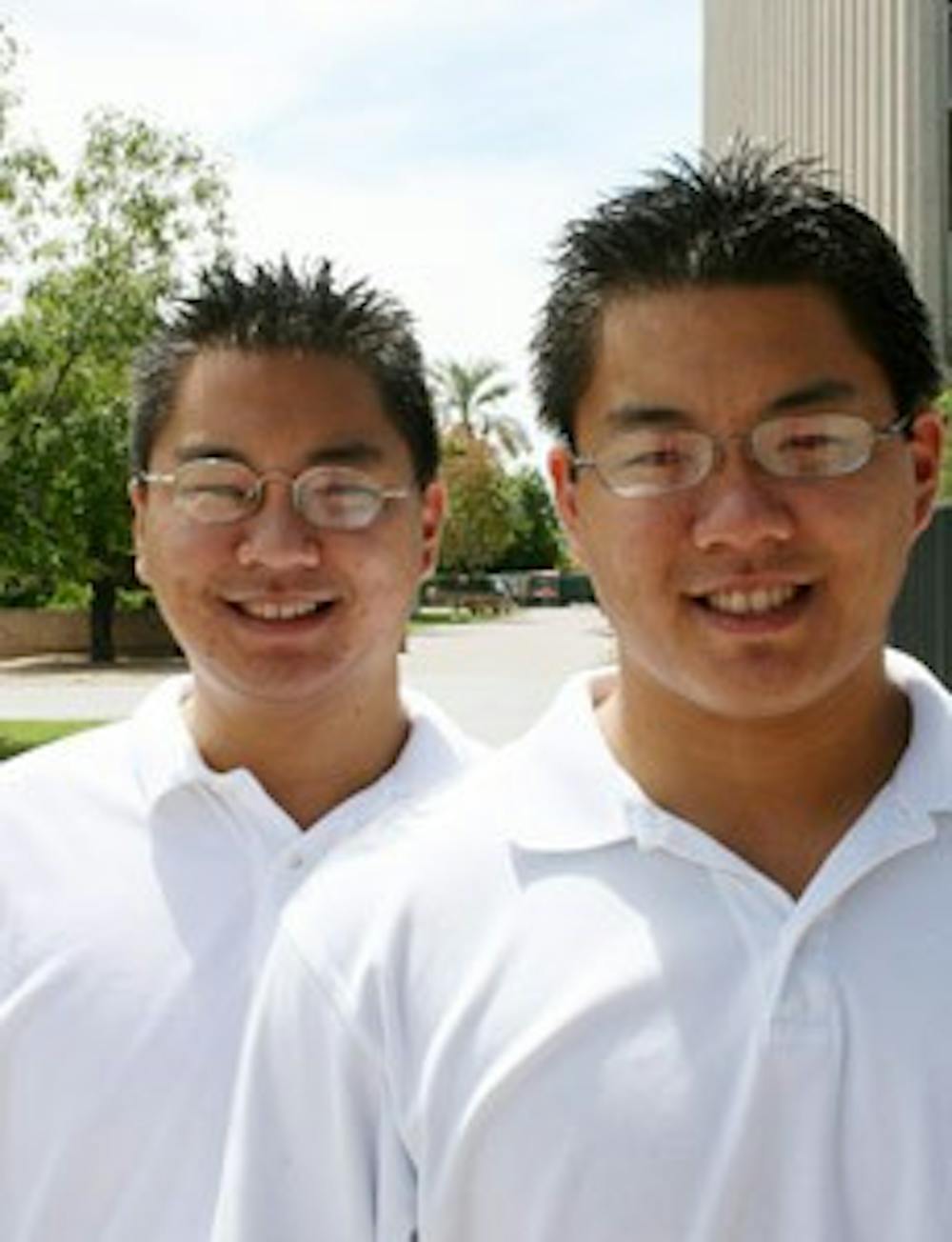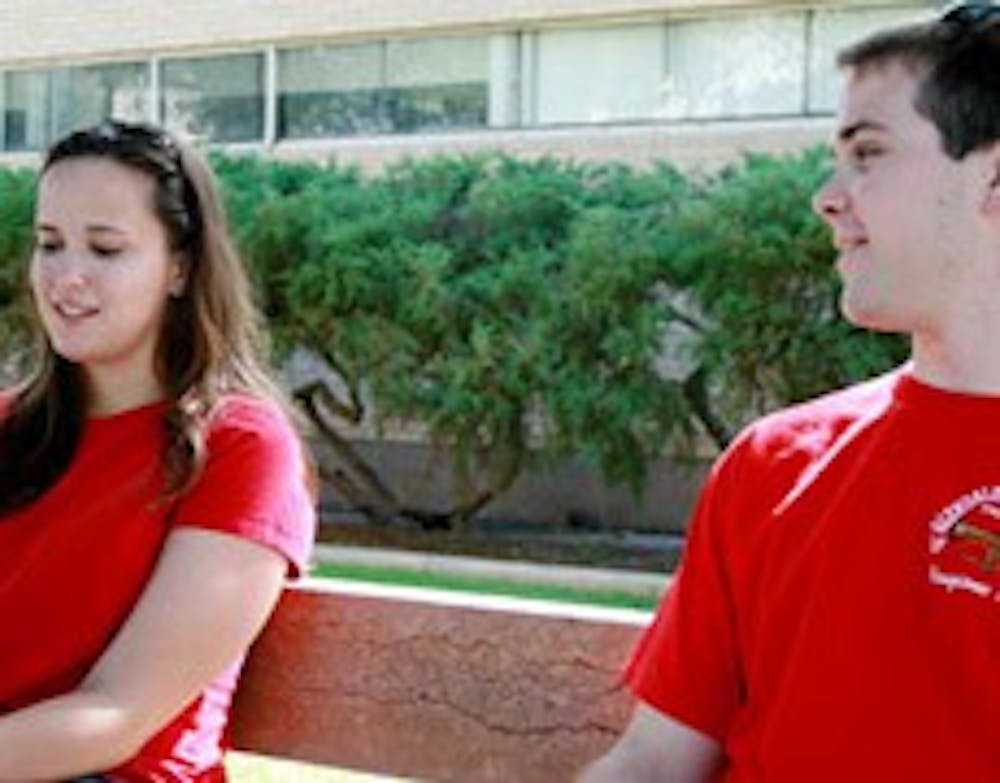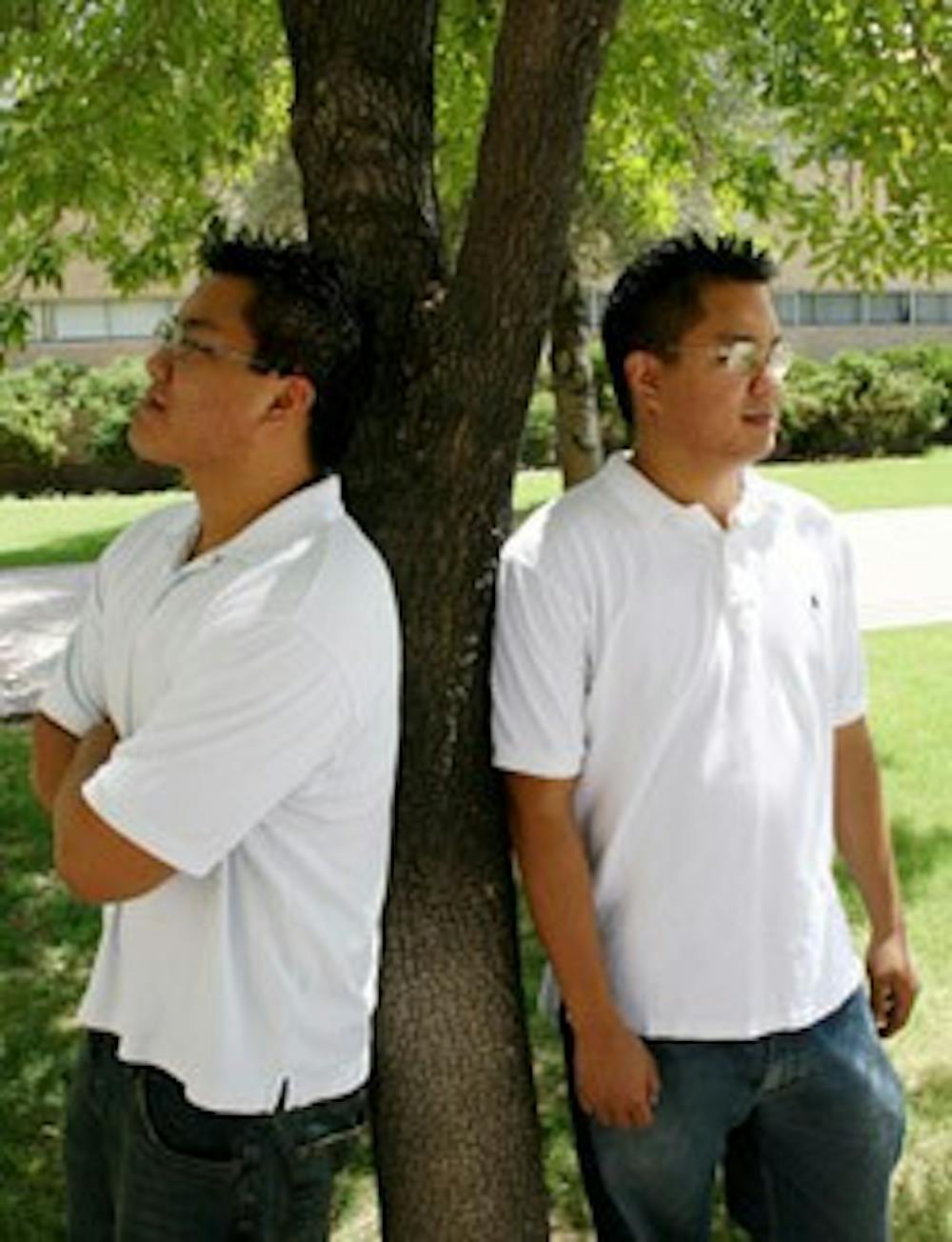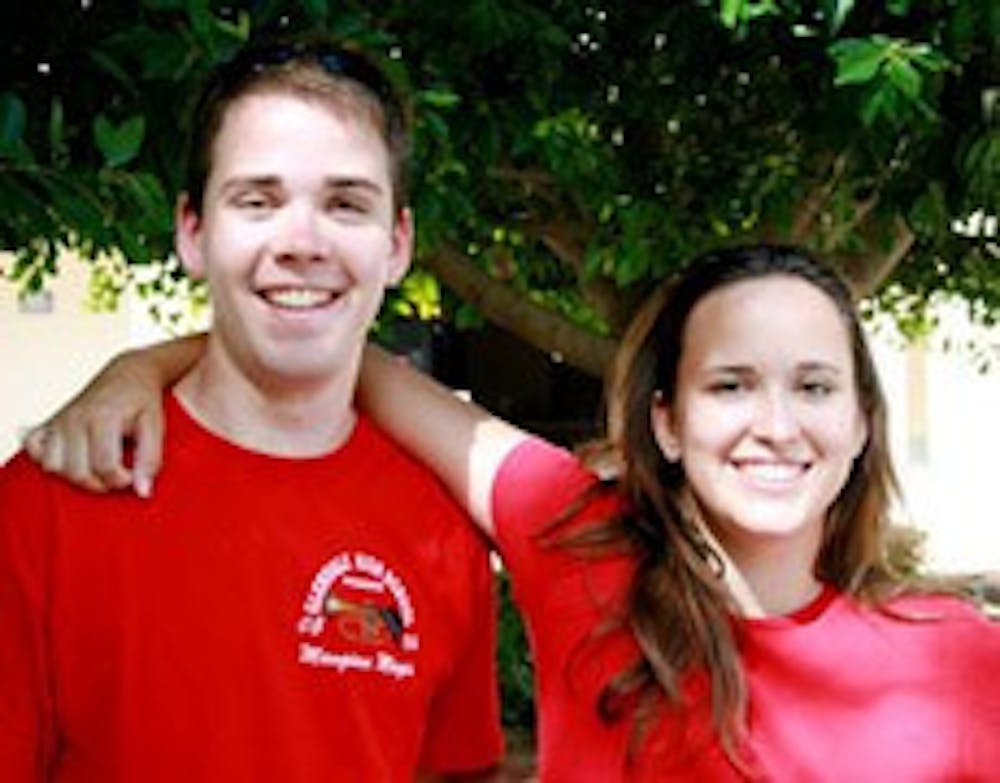On a hot Sunday afternoon in August, Danielle and Barry Lindsey move into their new Tempe condominium. Two bicycles rest by the door, and the view from the foyer reveals a cluttered kitchen and a living room littered with boxes.
The Lindseys are in the middle of it all, trying to figure out where to move a large brown couch. While the room is in disarray from the move, Danielle and Barry work together seamlessly. It's no wonder - they've been roommates on and off for more than 20 years.
No, Danielle and Barry are not married - they are twins.
But Danielle says their relationship wasn't always this smooth when they were younger.
"We did not get along at all," she says.
Barry says they always had the same classes, the same friends and their teachers always knew them, because their parents were their school's band directors.
Danielle adds, "We were very competitive, always."
'Potential for conflict'
Kimberly Updegraff, an associate professor in the School of Social and Family Dynamics, has done research on sibling relationships. She says competition between siblings is natural, but "generally there's a suggestion of greater intensity when they're closer in age."
This competition can be attributed to a number of factors, including trying to get attention from their parents.
"Competition for resources, more engagement," Updegraff adds. "There's more potential for conflict when they're closer in age."
Barry Lindsey knows what this is like. He says he and his sister have a different relationship as twins than most other siblings do. Because they are the same age, "There's not a protective instinct or anything," he says. "That other person is equal. You fight for your parents' attention."
But now, Danielle and Barry, both 21, have a different relationship.
"It's like night and day," Danielle says of the change. Essentially, the Lindseys grew up and overcame their competitiveness. Even though they both came to ASU for school, college meant a world of change. They both chose ASU because went there.
While they had one class together (band) during their freshman year, Danielle became a psychology major and Barry is pre-law.
"We've always been together - at home, at school," Barry says. "But in college we didn't see each other as much."
For the first time, they had different classes and lived on their own.
"We're doing our own thing," Danielle adds. "You can't compete between lawyer and psychologist."
Updegraff says this progression is customary with most siblings.
"There is a general pattern suggesting [siblings] get more egalitarian over time," she says. Most sibling relationships begin with a hierarchy, she explains, where the first-born has dominant control. "But they become looser to the idea of peer relationships or friendships."
However, Updegraff adds that some siblings innately tend to be closer. Sisters, for example, often share a closer bond. "Other [sibling relationships] aren't quite as close," she says.
The truth about twins
Despite the popularity of twin sisters like Mary Kate and Ashley Olsen, the public may still not understand the basics about these genetic pairs. Myths about twin relationships abound (see "Unmask the myths," sidebar), but the scientific details are fairly simple to understand.
Danielle and Barry are dizygotic, or fraternal, twins. These types of twins form from two fertilized eggs, which can produce twins of either the same or opposite sex.
The only other confirmed type of twin is monozygotic, or identical, twins. Identical twins come from just one fertilized egg. Unlike regular pregnancies, this egg splits into two halves that develop identically into children of the same gender.
According to the Arizona Department of Health Services, the number of twins born in Arizona each year has steadily increased since 1994, following a national trend of increasing births of multiples.
A report released by ADHS shows that in 1994, 1,568 twins were born in Arizona. But this number increased 59.4 percent to 2,500 twins in 2004 (a record high for the state). Twins aren't the only birth increase Arizona has seen in the past decade - triplets and other multiples (like quadruplets and quintuplets) increased 94 percent from 84 in 1994 to 163 in 2004, the report states. It also shows that, in contrast, the number of single births increased just 32.6 percent in this period.
Experts have attributed this increase in multiple births to older moms and the popularity of fertility treatments.
'Even Dad got confused'
Twins Henry and Jerry Huang, 21, are, as Jerry puts it, "supposedly identical." (Jerry wears glasses and his brother usually wears contacts. He also says Henry is taller by an inch.) Despite their similar appearances, Henry and Jerry are completely different people.
Jerry, a computer science senior at ASU, is always laughing and hanging out with his friends.
He dubs Henry, a sociology major at Mesa Community College, the more serious and work-oriented of the two. "[Henry] tends to be more angry, more aggressive," he says. Jerry says Henry also tends to be protective, since he is technically the older brother. "People say I'm the nicer one," Jerry adds, laughing.
In contrast, Henry says their biggest difference is that Jerry talks a lot more than he does. He says he's also the more athletic one.
Jerry agrees. "[Henry] goes to the gym and lifts weights," he says. "I try to, but I'm too lazy."
Since they've aged, Henry and Jerry have taken on their own appearances. "Since we look different right now, people don't realize we're twins until I put on my glasses or he takes his off," Henry says.
People who they are close to can recognize them separately from a mile away, they say. But that wasn't always the case.
"In middle school we were pretty identical," Henry says. "We both had glasses and our hair was the same. [Classmates] got us confused all the time."
Their peers and teachers weren't the only ones who couldn't always tell them apart. Henry says their dad even got confused sometimes, though their mom could tell them apart "only through our eyes."
Dare to be different
When they were younger, Henry and Jerry shared a lot more than their DNA. They say they shared teachers, friends, a room and toys.
Henry says the objects of most of their childhood fights were their game consoles. "It would be my turn or his turn [to play]," he says. "Sometimes I would play a little more and he would get mad."
Jerry says sharing things with his brother, including hobbies and friends, never bothered him. But Henry says sometimes got on his nerves.
"People think twins are closer," he says. "We don't always want to be together. Even sometimes we try different things to be an individual."
For example, Henry says he always played sports in middle school and high school to have his own niche apart from his brother. He also chose to go to Northern Arizona University for his first two years of college.
"When I chose to go to NAU, I guess that was trying to be different," he says.
Updegraff says striving to be different is one way siblings can try to minimize conflict.
"They choose different areas they excel in," she says. For example, if one kid chooses to be the rebel, the other kid might choose to be the straight-A student, just to take another route.
But Updegraff adds there are elements of larger family dynamics present in this relationship. She says that if the kids think their parents are showing favoritism, there tends to be more conflict between the siblings.
Either way, Updegraff says, her research has shown that sibling relationships are a major factor in kids' lives. "You spend more time with siblings than anyone else," she says. In most American families, kids spend an average of 10 hours a week with their siblings. With their weeks split between school, friends and family, this is a large portion of devoted time.
"Siblings are important in a lot of ways," she adds. "They can be good role models, but they can lead you along the wrong path also. There are a lot of ways siblings are good for children and a lot of ways they can get you in trouble."
Danielle Lindsey says having her brother with her throughout school gave her more confidence. "I always had a good study buddy," she says. "He could help me with math. We always did really well in school. Having each other there helped with that."
She says it never bothered her that she and Barry did things together or had the same friends. They even chose to go to prom in the same group.
"We did a lot of stuff together," Danielle says, making living with her twin seem like the perfect setup, despite most siblings' aversion to such an idea. "I can always count on him," she adds.
Unmask the myths
By Tara Brite
From Lindsay Lohan's pre-booze hound appearance in "Parent Trap" to "The Cooler Twin" group on Facebook.com, it's clear that people are fascinated with twins. But which myths surrounding these pairs are true?
One twin is always evil.
This myth has been popularized throughout time, in sources ranging from Greek mythology to South Park. (In one episode, Cartman's "evil" twin appears through a space-time portal, sporting a goatee and a nicer attitude.) But the myth is only partly true. One twin isn't always "evil," but siblings close in age often choose to excel in different areas, says Kimberly Updegraff, an associate professor in the School of Social and Family Dynamics who has done research on sibling relationships. "There are strategies where kids find different niches," she says. This means that if one twin chooses to rebel, the other will often play the goody-two-shoes role to establish his or her individuality.
Twins have ESP.
This one is simple-they don't. ESP, or extrasensory perception, is considered a sixth sense, where one person can tell what the other is thinking. Though this is a controversial subject, most twins say they can sense how their twin feels only because they are similar in other ways, like being raised in the same household with similar beliefs. Computer science senior Jerry Huang says he and his identical twin, Henry, dismiss the ESP myth. "Sometimes we say the same thing," he says. "But it's just a coincidence."
Twins can feel each other's pain.
Psychology senior Danielle Lindsey says people often ask her and her twin brother, Barry, if they can feel each other's pain. "When we were little, people asked, 'If you cut your finger, can your brother heal it?' " she says. Her answer? "No." While some twins say they can feel their sister's knee aches or brother's football injuries, this claim is not universal. Some scientists suggest this link is psychological and shared by all people who have close relationships.
Reach the reporter at: tara.brite@asu.edu







